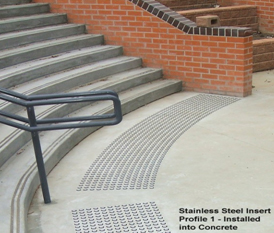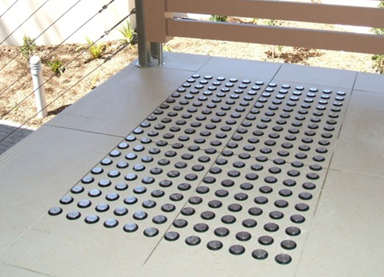Tactile Ground Surface Indicator – TGSI
Tactile Ground Surface Indicator’s purpose is to provide a tactile surface on public pathways & access routes that can be felt underfoot and recognised as a warning of impending pedestrian hazard, particularly to the vision impaired, but also as an added safety precaution to all pedestrians.
AS/NZS 1428.4:2002 controls the product and the installation requirements of Tactile Indicators.
The manufacturer has recognised the need for a range tactile indicators that is extremely functional, durable, economical & complimentary to any architecture standard. This was achieved by utilising the best materials available and considerable consultation with engineers and architects. The result is a product that looks and performs like no other.
 The major points to be aware of regarding to TGSIs are;
The major points to be aware of regarding to TGSIs are;
- Types of indicators are, warning indicators and directional indicators
- Luminescence contrast requirements
- Placement requirements
Regarding to placements the standard states;
This Appendix provides details on the application of TGSI in various situations.
The following situations are covered:
(a) Stairways, ramps, escalators, and travelators.
(b) Car park crossings.
(c) Bus stops.
(d) Trams/light rail.
(e) Level path/carriageway junctions.
(f) Railway platforms.
(g) Passenger wharves.
(h) Projecting hazards in circulation spaces.
(i) Change of direction, directional indicators
SPECIFICATIONS
- Manufacturing
All stainless steel is marine grade 316, which has been further processed to ensure a lifetime of performance & resistance to corrosion.
Plastic content of the metal insert and full metal range is modified to withstand impact & the environment. Full plastic models are manufactured from polyurethane to provide a tough wear resistant quality. Each component is automatically assembled utilising a patented mechanical technique, to ensure continued durability - Quality
The manufacturing processes utilise the latest technology available to ensure accurate repeatability. A vigorous inspection procedure is also implemented to maintain that only the highest possible quality component meets the requirements of AS/NZS 1428.4, for performance & design. - Compliance
The tactile indicator Profile 1 (patent pending) has been tested by CSIRO to verify the suitability of the product in a pedestrian environment. This component was rated at R13 (38.2Deg),to AS/NZS 4586:2004, Appendix D, which significantly exceeds the requirements & ensures a safety advantage.
To get the independent test result, click on Slip Resistance Test
Installation
Extensive practical experience has proven that there is no substitute for mechanical fixing. Fixing a Tactile Indicator onto an existing pedestrian floor with adhesive has proven to date to be less reliable than we considered acceptable. We will however continue to research this option.
All Indicators currently have a profiled plug incorporated into the design of each tactile indicator which suits a pre drilled 8mm hole. The depth of hole is dependant on the substrate material. Typically a 25mm depth hole is sufficient when fixing the tactile indicator to concrete.
The manufacturer will provide a full package including specially designed drilling templates, drills, to assist with drilling to the required matrix standard. These templates are available in various formats like 300mm x 600mm or 600mm x 600mm and others. Location pins are supplied to allow for easy longer matrix applications.






